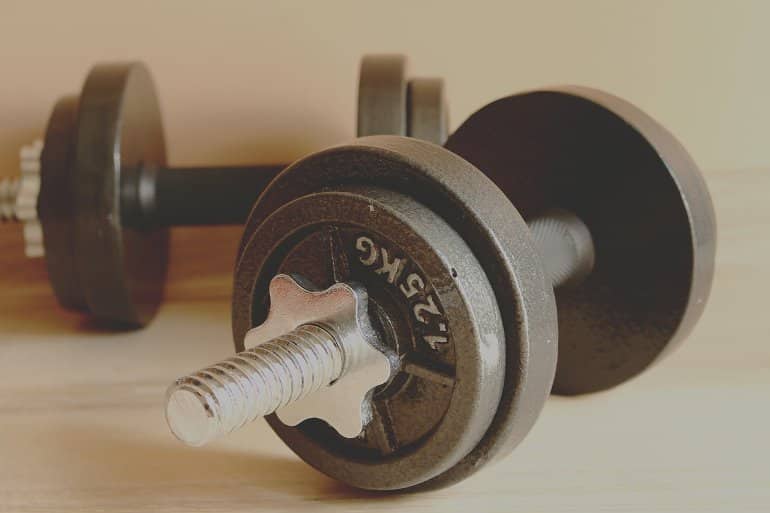Summary: Lifting weights for just three seconds a day can have a positive impact on muscle strength, a new study reveals.
Source: Edith Cowan University
Lifting weights for as little as three seconds a day can have a positive impact on muscle strength, a new study from Edith Cowan University (ECU) has discovered.
A collaboration with researchers from Niigata University of Health and Welfare (NUHW) in Japan had 39 healthy university students perform one muscle contraction at maximum effort for three seconds per day, for five days a week over four weeks.
The participants performed either an isometric, concentric or eccentric bicep curl (see definitions below) at maximum effort, while researchers measured the muscles’ maximum voluntary contraction strength before and after the four-week period.
Another 13 students performed no exercise over the same period and were also measured before and after the four weeks.
Muscle strength increased more than 10 percent for the group who performed the eccentric bicep curl after the four weeks, but less increase in muscle strength was found for the other two exercise groups.
The no exercise group saw no increase.
Lead researcher Professor Ken Nosaka from ECU’s School of Medical and Health Sciences said the results showed people didn’t need to spend vast amounts of time exercising to improve their muscle strength.
“The study results suggest that a very small amount of exercise stimulus – even 60 seconds in four weeks – can increase muscle strength,” he said.
“Many people think you have to spend a lot of time exercising, but it’s not the case. Short, good quality exercise can still be good for your body and every muscle contraction counts.”
Isometric vs concentric vs eccentric
These three classifications relate to what the muscle is doing when being activated.
An isometric contraction is when the muscle is stationary under load, concentric is when the muscle is shortening and eccentric when the muscle is lengthening.
For a bicep curl, a dumbbell held with an arm by one’s side, before lifting the weight upwards towards the chest and then lowering it back down via the elbow.
Lifting the weight sees the bicep in concentric contraction, lowering the weight sees it in eccentric contraction, while holding the weight parallel to the ground is isometric.
So… which is best?
The study shows all three lifting methods had some benefit to muscle strength, however eccentric contraction easily produced the best results.
Researchers measured each group’s concentric, isometric and eccentric strength.
The concentric lifting group improved slightly (6.3 percent) in isometric strength but saw no improvement elsewhere, while the isometric group only saw an increase in eccentric strength (7.2 percent).
However, the eccentric group saw significant improvements in strength across all three measurements: concentric increased 12.8 percent, isometric 10.2 percent and eccentric 12.2 percent.

The eccentric group’s overall muscle strength improved 11.5 percent after 60 seconds of effort in total.
“Although the mechanisms underpinning eccentric contraction’s potent effects are not clear yet, the fact only a three-second maximal eccentric contraction a day improves muscle strength in a relatively short period is important for health and fitness,” Professor Nosaka said.
Time-poor no more
Professor Nosaka said the findings were exciting for promoting physical fitness and health, such as prevention of sarcopenia – a decrease in muscle mass and strength with aging.
“We haven’t investigated other muscles yet, but if we find the three-second rule also applies to other muscles then you might be able to do a whole-body exercise in less than 30 seconds,” he said.
“Also, performing only one maximal contraction per day means you don’t get sore afterwards.”
Professor Nosaka and NUHW’s Dr Masatoshi Nakamura designed the study and the data were collected by Dr Nakamura and his PhD and Masters students.
About this exercise research news
Author: Sam Jeremic
Source: Edith Cowan University
Contact: Sam Jeremic – Edith Cowan University
Image: The image is in the public domain
Original Research: Closed access.
“Effect of daily 3-s maximum voluntary isometric, concentric or eccentric contraction on elbow flexor strength” by Ken Nosaka et al. Scandinavian Journal of Medicine and Science in Sports
Abstract
Effect of daily 3-s maximum voluntary isometric, concentric or eccentric contraction on elbow flexor strength
The present study compared a 3-second isometric maximal voluntary contraction (MVC), concentric MVC and eccentric MVC of the elbow flexors performed daily for 5 days a week for 4 weeks for changes in muscle strength and thickness. Young sedentary individuals were assigned to one of three training groups (n=13 per group) that performed either 3-second isometric, concentric or eccentric MVC once a day for 20 days, or to a control group (n=10) that had measurements without training.
The participants in the isometric group performed isometric MVC at 55° (0.96rad) elbow flexion, and those in the concentric or eccentric group performed concentric MVC or eccentric MVC between 10° (0.17rad) and 100° (1.75rad) elbow flexion at 30°/s (0.52rad/s) on an isokinetic dynamometer. MVC isometric torque at 20° (0.35rad), 55° (0.96rad), and 90° (1.57 rad) elbow flexion, MVC concentric and eccentric torque at 30°/s (0.52rad/s) and 180°/s (3.14rad/s), and muscle thickness of biceps brachii and brachialis were measured before and several days after the 20th exercise session.
The control group did not show any changes. The eccentric group showed increases (p<0.01) in isometric (three angle average: 10.2±6.4%), concentric (two velocity average: 12.8±9.6%) and eccentric MVC torque (12.2±7.8%). An increase (p<0.05) was limited for isometric MVC torque (6.3±6.0%) in the concentric group, and for eccentric MVC torque (7.2±4.4%) in the isometric group. No significant changes in muscle thickness were evident for all groups.
Performing one 3-second MVC a day increased muscle strength, but eccentric MVC produced more potent effects than isometric or concentric MVC.







